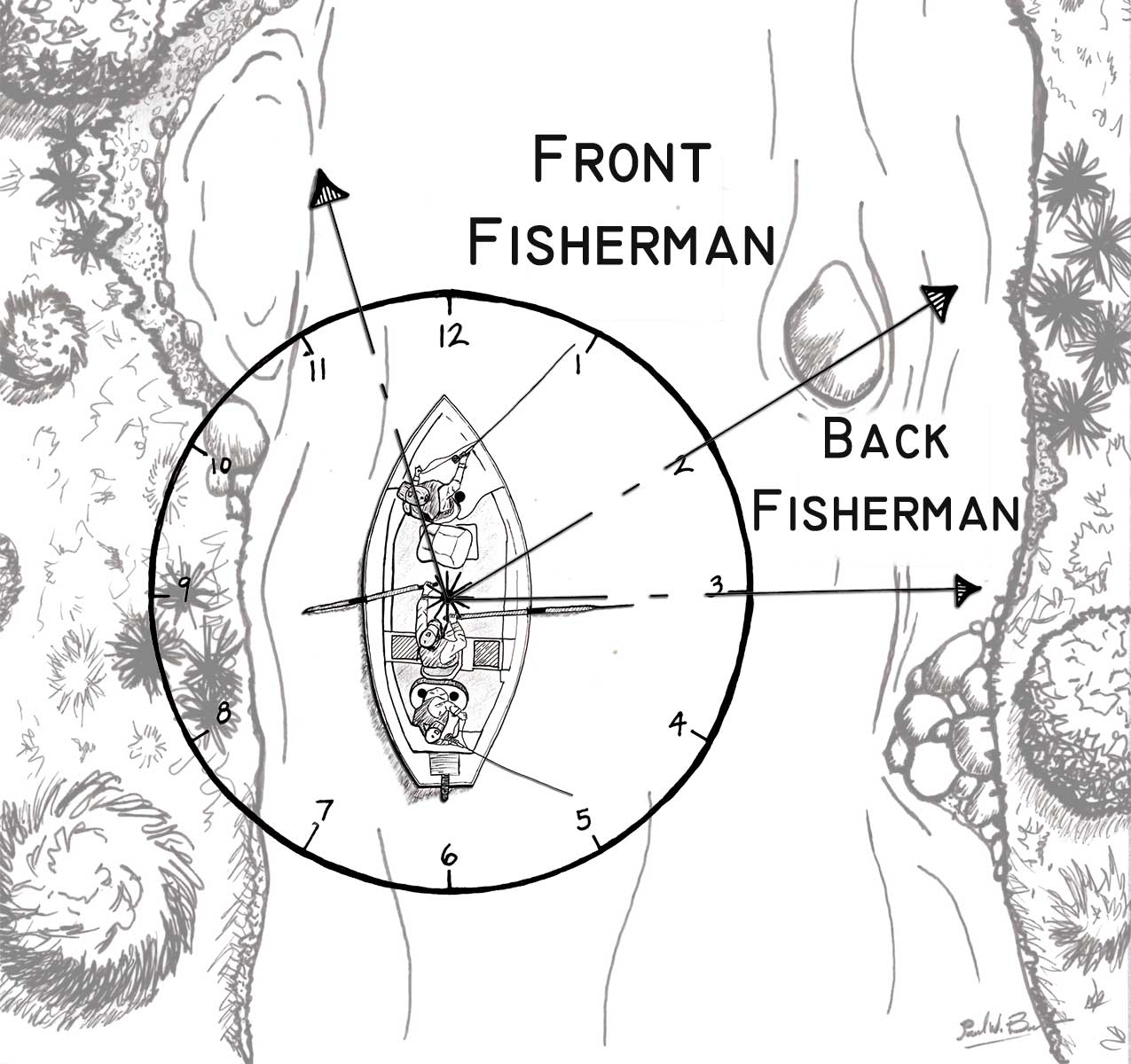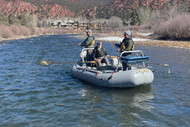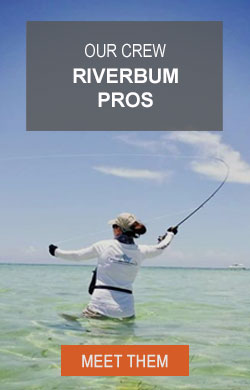How To Row A Drift Boat Or Raft: 13 Tips To Catch More Fish
If you want to catch more fish on your next float trip, you need to learn how to row a drift boat or raft properly.
In this guide, I'm going to reveal 13 of my top rowing tips to help you get down the river safely, and maximize your fish-catching opportunities.
Let's get started.
1) Get Down The River Safely (And Slowly)
I hope this goes without saying, but goal number one when rowing a drift boat or raft is to get down the river safely. No matter how big the fish might be, it isn’t worth risking your life or the life of others.
Goal number two is different.
For the White-Water trip, the thrill is going fast through the big hole, getting wet, and running down the wave trains.
Rowing for fishing, on the other hand, means going SLOW.
Not only does it provide more control, but back-rowing allows the fisherman more time at each hole.
Remember, fish don’t live in the crazy-fast-moving water, so you want to spend your time in eddies, along bubble lines, near riverbank cuts, and other cover.
2) Row Backwards More Than Forwards
The first thing to remember is to SLOW EVERYTHING DOWN.
You will row in a backstroke 90% of the time.
Point your boat toward the danger and pull away from the danger. You want to be out of the main current. The fish don’t live there, so you shouldn’t be there.
Your goal as the rower is to put the fisherman where the fish are so look far downstream for your target.
This will give you more time to fish that target without the shadow of the boat spooking the fish.
3) Place The Boat Within The Casting Capabilities Of The Fisherman
Being 30 yards from a target won’t work if your fisherman can only successfully cast 20 yards.
The Rower is as important as the fisherman. The rower may also need to take the wind into consideration as it will lengthen or shorten one’s casting ability.
4) Fish Where The Fish Are
Fish don’t live everywhere in the water.
Fish will be where there is shelter--like an undercut bank and overhanging trees. Fish will hang where there is food. Fish also like to spend time in highly-oxygenated water.
Fish will not be in the fast current, but they will live near that faster current. Look for bubble lines.
Eddies and pools are great places to find the fish as well. They will also hang out behind large boulders. Fish are most often found two to six feet from the bank.
Be sure to cast away from the boat (downstream). Mend, mend, mend. Presentation is critical. Be sure to set on every tick. Slowing the boat down and using eddies will help your fisherman be successful. Once you know where the fish are holding, target the same type of water as you float downstream.
5) River Right, River Left
It is critical for the fisherman and the rower to understand the difference between river right and river left.
It doesn’t matter what way you are facing on the boat; river right is always the right side of the river if you are looking downstream.
Just because you move around on the boat and in the river, River Right and River Left do not change.
6) The Fishing Clock

Typically, you will have two fishermen on board, one in the bow (front) of the boat and one in the rear (stern) of the boat.
Explain to everyone on board, that if you think of the boat as an analog clock with twelve o’clock being the front of the boat and six o’clock being the rear of the boat. (rowers seat is the center of the clock[JP1] ) This will make it easier for the fishermen to know where to cast.
The Rower can tell them to cast to two o’clock instead of saying, cast over toward that boulder, not the other boulder not that one.
It is important to know the skills level of your fisherman before you go.
The better fisherman should be in the back of the boat. Putting the less accomplished fisherman in the front of the boat will give them more room for error in casting and help them be successful. This setup is also best for the rower.
No one wants to get a fly stuck in the ear, neck, or anywhere other than in a fish’s mouth. The front of the boat fisherman will fish the water between ten o’clock and two o’clock positions.
The back of the boat fisherman will fish between two o’clock and four o’clock position and between eight o’clock and ten o’clock position.
7) Break The River Into Pieces
Look for weed beds, inside bends in the river, outside bends in the river, and cut banks.
There are all good places to find the fish. Fish also like to hang out in the mid-river foam lines. Eddies downriver from larger boulders are good resting spots for the fish while they wait for food to come by.
Fishing from slow water into faster water is a good spot to find fish.
Be sure to have your fishermen take turns casting in the approach to avoid tangles. Big eddy lines on inside bends almost always have fish. Cover this area with a team approach.
The boat can be rowed or anchored in the slow-water zone.
8) Understand Your Targets
Knowing the difference between a pocket, seam, and an eddy will help your fisherman be successful on the river.
A pocket is the area right behind (downriver of) a boulder in the river. A seam is the area where the fast-moving water meets a slower body of water and creates a “seam” again after the boulder, or bank jetting out into the river, where the water starts to flow again.
An Eddie is the section of water where a calm pool forms. Often the water current in an eddy will move you back upstream.

9) Casting Tips And Tricks
First and foremost, please crimp your hooks.
This is the best way to help the fish survive to allow you to catch them another day. It is also much easier to get a crimped hook out of your hand, ear, net, clothing, and pretty much anything else on the boat.
Fisherman should cast on the same side of the boat.
This will make it easier for the rower to line up on target areas and will significantly reduce the chances of the lines getting tangled.
As the fishermen, you need to learn to pick up and lay down your line on the river. The roll cast works well on a boat as so does a sidearm cast. Try to eliminate casting over the boat.
The person in the back of the boat controls the tangles which are always the back fisherman’s fault.
The front person cannot see the back person, so it is the rear fisherman’s job to pay attention and avoid getting the lines tangled when casting. Be sure to look downstream and be prepared for what is coming next.
As you float down the river the depth will be constantly changing. Always be prepared and adjust your rig as needed.
10) The Importance of Boat Position
Typically, there are always two fishermen on board. As the rower, it is your job to get them both to the feeding fish. If the boat moves, their target moves, which is why back rowing is so important.
It gives the fishermen more time at each target to catch fish.
Fish are easily spoked, so making subtle boat movements are best. Be aware of the boat’s shadow. It will spook the fish.
Be sure to place your oars in the water quietly. Slapping the oar down flat on the water is a sure way to send the fish scattering.
Do everything you can to NOT spook the fish.
11) The Crawl Stroke
The crawl stroke it is a great way to help you “grab an eddy”.
This stroke also keeps the fishermen in position longer by keeping the boat parallel to the shore and therefore increasing their chances of catching fish.
This stroke allows the boat to be close to shore with minimal disturbance to the water and fish. It allows you to move sideways while slowing the boat at the same time.
The oar on the side of the boat that you want to move towards is a sweeping stroke with the oar pointing towards the front of the boat. The opposite side oar is a simple pull stroke, and used to keep the boat pointed in the direction the rower desires.
Master this stroke as it is the most important stroke while in slower, calm water.
12) Use The Right Equipment
When float fishing you will need a raft, dory, or pontoon boat. Lean bars and a stable floor on your boat will help the fishermen be stable which will help them catch fish and not fall out of the boat.
Make sure you have a good anchor.
This will make it much easier when you are netting fish, untangling lines, and when you want to stay in one spot on the water for a while.
Rod holders are key to keeping your equipment safe and readily available. Be sure to have a net with a long handle. The long handle works so much better to grab the fish from the boat than your shorter wade fishing net.
Be sure to have proper safety equipment on board. PFDs for everyone on board, a first aid kit, a throw bag (to help get people back in the boat if they fall out), and a dry set of clothes, just in case. Nine-foot rods in a five or six weight are best on the river.
7-foot or 9- foot leaders and fluorocarbon tippet are essential for your success on the river. Having multiple set up rods is the best plan and be sure to bring plenty of flies for the trip.
13) Practice Rowing
Spend time in the boat rowing. The more time on the sticks the more proficient you will become.
Take a lesson.
Rowing lessons are a great way to build your skill and confidence on the river. If you want to quickly learn how to row and fish a particular river go out with a fishing guide.
Most importantly, remember that the Rower’s main responsibility is to get safely down the river.
Fishing is the second priority.







